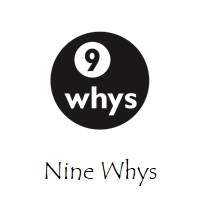
Nine Whys helps teams identify their purpose
With Nine Whys, you can rapidly clarify for individuals and a group what is essentially important in their work. You can quickly reveal when a compelling purpose is missing in a gathering and avoid moving forward without clarity.
A purpose is the main reason for working together, “an inexhaustible reason for a group to exist”. A clear purpose helps teams align toward a shared goal.
When a group discovers an unambiguous shared purpose, more freedom and more responsibility are unleashed. You have laid the foundation for spreading and scaling innovations with fidelity.
Four Structural Elements
1. Structuring Invitation
- Ask, “What do you do when working on __ (the subject matter or challenge at hand)? Please make a short list of activities.” Then ask, “Why is that important to you?” Keep asking, “Why? Why? Why?” up to nine times or until participants can go no deeper because they have reached the fundamental purpose for this work.
2. How Space Is Arranged and Materials Needed
- Unlimited number of groups
- Chairs for people to sit comfortably face-to-face; no tables or equipment needed.
3. How Participation Is Distributed
- Everyone has an equal opportunity to participate and contribute
- First pairs, then groups of four, then the whole group (2-4-All)
4. Sequence of Steps and Time Allocation
- Each person in a pair is interviewed by his or her partner for 5 minutes. Starting with “What do you do when working on __?” the interviewer gently seeks a deeper answer by repeating the query: “Why is that important to you?” Switch roles after 5 minutes. 10 min.
- Each pair shares the experience and insights with another pair in a foursome. 5 min.
- Invite the whole group to reflect by asking, “How do our purposes influence the next steps we take?” 5 min.
Purposes and Objectives
- Discover what is truly important for the group members
- Lay the groundwork for the design that will be employed
- Ignite organizational momentum through the stories that emerge
- Generating a small number of clear answers can help you move forward together with more velocity
- Provide a basis for progressive evaluation
- Generate criteria for deciding who will be included
Tips
- Traditional organizational design unconsciously keeps teams separated from a true purpose. Only the higher-ups really know why something is being done. Using Nine Whys in this scenario can help change initiatives get started.
- The purpose has several layers. You can always go deeper or more shallow. You have found the right level when the purpose statement feels gripping, exciting and ambitious.
- A purpose is never truly final. It’s often a good idea to take a purpose statement for a “test drive”, see if it rings true in daily life and then sharpen it later on.
- Make sure the question asked is, “Why is it important to YOU?” (meaning not the amorphous organization or system but you personally)
- Share the variety of responses and reflect on differences among group members. What common purpose emerges?
- If someone gets stuck ask, “Does a story come to mind?”
- Maintain confidentiality when very personal stories are shared
- Make clarifying purpose with Nine Whys a routine practice in your group
Examples
- For crafting a compelling shared purpose to launch a collaborative research organization
- For the beginning of any coaching session
- For clarifying the purpose behind the launch of a new product
- For anchoring each element of a Design Storyboard by asking, “Why is this activity or element important to you? What does it add to the flow of exchanges among participants?”
- For you as an individual to clarify your personal purpose


